TAMPA, Fla. — The words on the trophy read “Future Philanthropist,” and Mrs. Finley, who taught fifth grade that year, cried when she presented it to Andrew Weber during graduation.
Andrew smiled at the memory.
“It was one of the highlights of my elementary school career,” he said. “Mrs. Finley said I was one of her favorite students. That meant a lot to me.”
So did receiving the trophy, which still holds a place of honor on his nightstand.
“It made me realize my potential and how I can help others,” Andrew said.
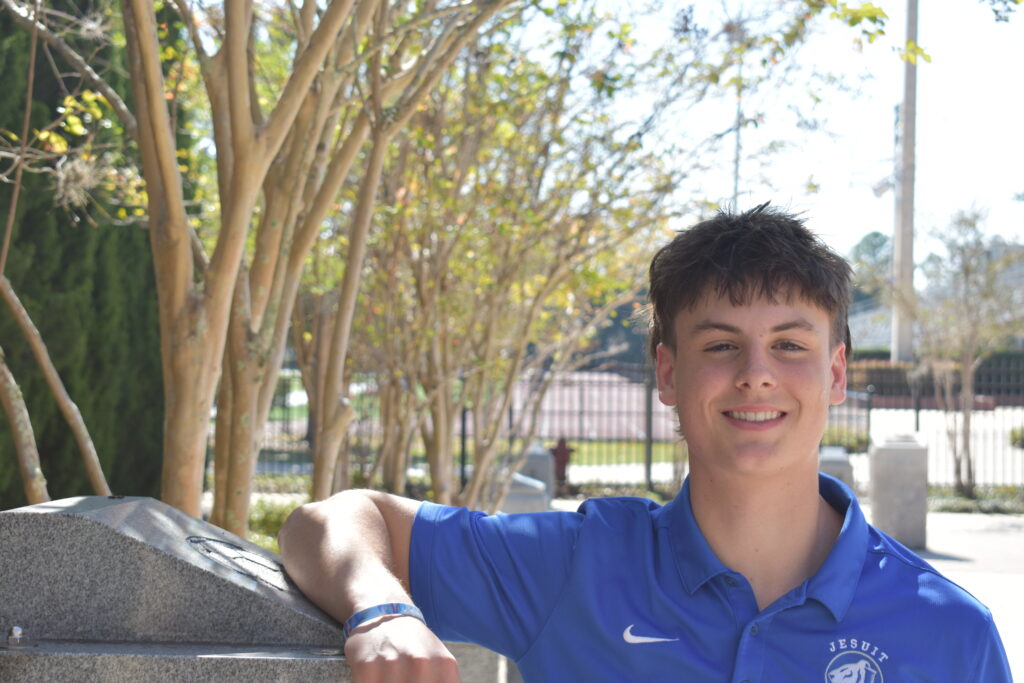
Almost seven years later, Andrew, a 17-year-old senior, is nearing another graduation, this time from Jesuit High School, the Catholic school in Tampa he attends with the help of a Florida education choice scholarship.
The altruistic nature Mrs. Finley saw in Andrew when he was in elementary school blossomed during the ensuing years.
Jesuit’s mantra is “Men for Others,” and Andrew embodies that.
“He does 100%,” said Andy Wood, Jesuit’s athletic trainer and track and field coach, and the school’s former director of community service. “Andrew is one of our top students. And when you talk about a total package, including his community service work, being a student athlete, he's what we envision our seniors being at graduation.”
Andrew volunteered for eight service organizations while in high school.
He made two trips to an orphanage in Guatemala with his Jesuit classmates, feeds people at Metropolitan Ministries, and delivers Meals on Wheels with his mother, May.

He’s volunteered for the Faith Café, the Young Men’s Service League, Teens United Florida, the Leukemia and Lymphoma Society, and the Ryan Nece Foundation, a non-profit founded by a former Tampa Bay Buccaneer that empowers teens to become leaders through volunteering.
Andrew traveled to Asheville, North Carolina, last June with the Ryan Nece Foundation to help families with home repairs still needed after the flooding caused by Hurricane Helene.
He is a pole vaulter on the track and field team, and in his spare time, he plays the piano at a local nursing home.
As a junior, Andrew received the Anne Frank Humanitarian Award from the Florida Holocaust Museum in Tampa for his outstanding humanitarian efforts.
Andrew’s parents, May and Tim, raised him and his older sister, Elise, to be community-minded. Elise, now a sophomore at the University of Georgia, also volunteered for the Ryan Nece Foundation while in high school.
“As his parents, we always wanted Andrew to be very involved in a lot of things and explore different passions, and luckily for him, many of those passions really stuck,” May said.
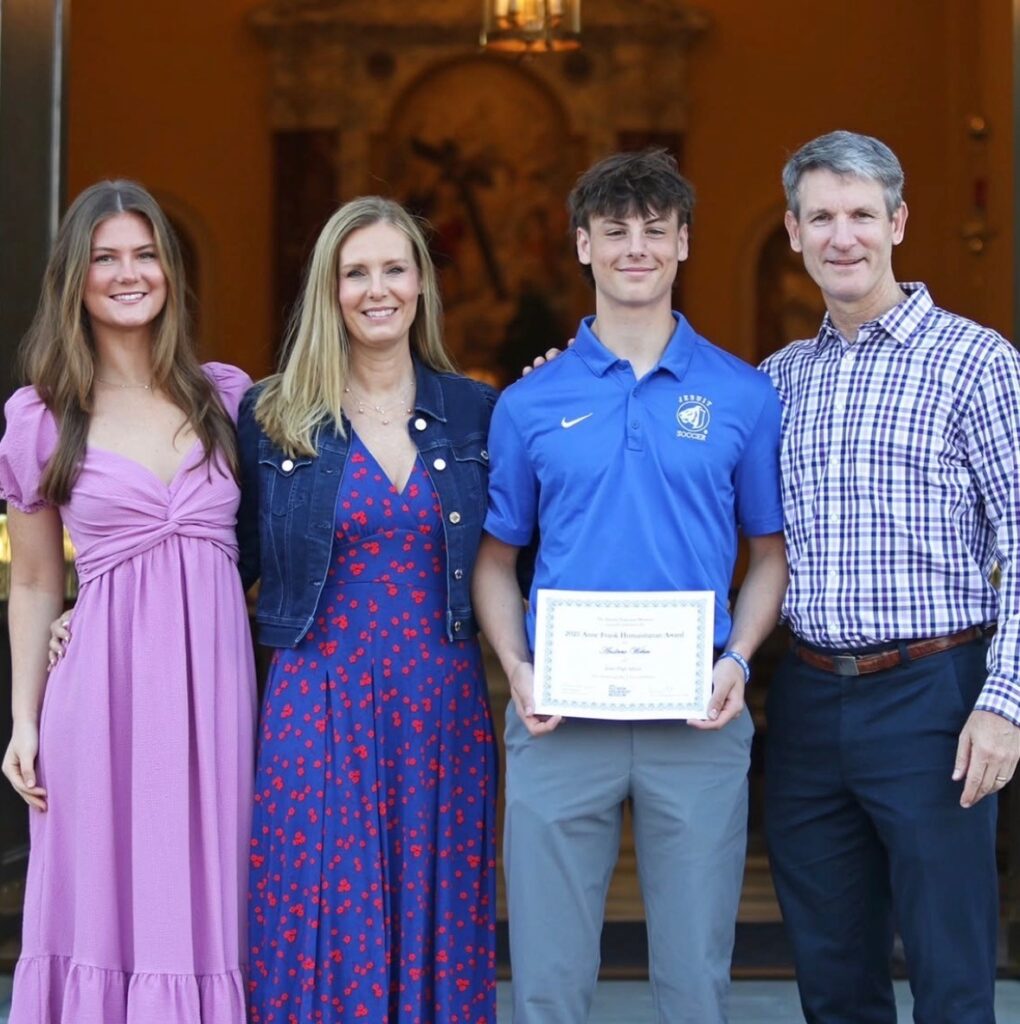
Andrew set the foundation in elementary school when he sold lemonade, handmade crafts, and rocks (crystals and gems) from a stand in the front yard of the family’s Tampa home. He said he would raise maybe $100 over several weeks and donate the money to charities such as Dogs Inc (formerly Southeastern Guide Dogs).
“I was 8,” he said. “I felt the money could benefit other people more than it could benefit me.”
“His heart was always generous,” May said.
For a teenager as service-oriented as Andrew, he certainly found a home at Jesuit, where students are required to complete a minimum of 150 hours of community service during their four years. Andrew, though, has accrued more than 500.
Yet, the decision to attend Jesuit was not easy.
“It was a very hard decision,” Andrew said.
His options were these: his district school, where Elise was a rising junior and where a lot of his friends were headed, or Jesuit, an all-male parochial school with demanding academic standards.
For help, Andrew turned to his role model: his big sister.
“She said, ‘Andrew, if you pass up this opportunity, you might regret it for the rest of your life.’ So I said, ‘I'm going to listen to you,’” Andrew said.
Thinking back on it now, Andrew added, “She was right.”
He has no regrets.
Andrew’s two trips to Orfanato Valle de Los Angeles (the Valley of the Angels orphanage) outside of Guatemala City with his classmates opened his eyes to how fortunate he is to live in America.
The orphanage did not have air conditioning, and hot water was spotty at best.
Wi-Fi? Yeah, right.
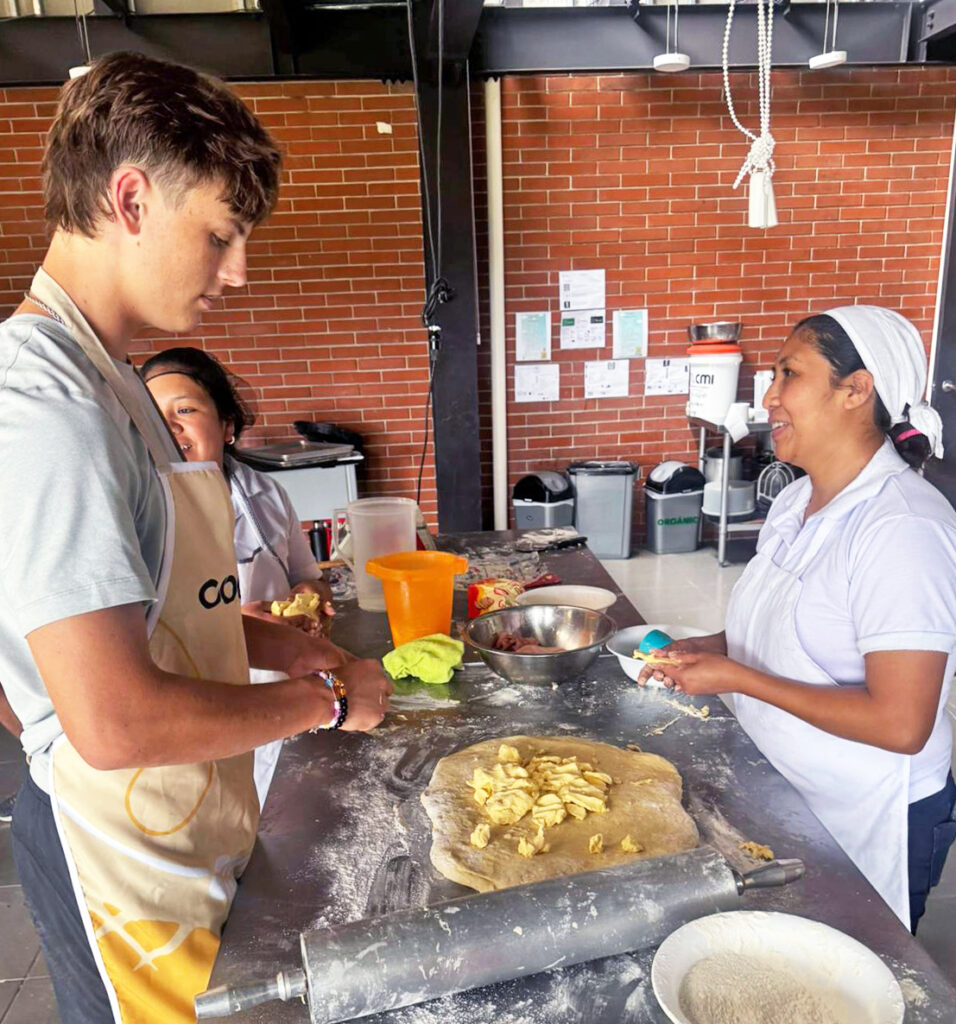
“I just put down my phone and started living in the environment, living how these kids live, and I realized that life can be fun,” Andrew said.
The Jesuit students spent nine days with at-risk children, teaching them English and about their faith.
Andrew called the experience “life-changing.”
“In Tampa, we really live in a bubble,” he said. “There are things I don’t take for granted anymore.”
Like AC, hot water, and a strong Wi-Fi signal.
And how a simple act of kindness can make a world of difference in someone’s day.
During the summers, he and his mom deliver Meals on Wheels to older adults and others unable to leave their homes without difficulty. It’s a bonding moment between the two, quality time spent together for a mom and her son.
“It's probably my favorite thing that we have done together,” May said.
“It’s the favorite thing that I do,” Andrew said.
They don’t rush through their route. Instead, they spend a few minutes at each stop, checking on the people receiving the meal, making small talk, and letting them know they matter.
When they first started delivering the meals, May told Andrew: “We’re probably the only people they're going to talk to that day, so even though this is sort of a blip on your radar, this is their day; this is their weekend; this is their week. So, make it count.”
Andrew took that lesson to heart.
A man for others.
“I feel like if I were in that situation where I needed help, I obviously want someone to do the same thing for me,” he said. “Spreading Jesuit’s values across what I do is a big part of why I do it. What I've learned here, it really propels me to do what I do in such a great way.”
Andrew wants to major in business in college. Where? He hasn’t decided. His choices are the University of Georgia, the University of Tennessee, Boston College, and Florida State University.
Where will that major lead him? He’s not sure.
“I can tell you it will be with people,” May said. “Whether it's finance or accounting, marketing or entrepreneurship, his love is working with people. I think it's just what comes naturally to him. He motivates people and makes people feel better about themselves. So, that’s my prediction.”
Each school day at 2:35 p.m., Joshua Jones enters a classroom at Crescent City Junior-Senior High School and settles into an agriculture class for eighth graders.
It’s the only class Joshua attends at the school, located about six miles from his home. And it caps the academic portion of his day, which starts at 8:30 a.m. sharp when he and his younger siblings, Jacob (sixth grade) and Kylie (fourth), begin their home education with their mother, Ashley.
The Jones children receive Personalized Education Program (PEP) scholarships available through the Florida Tax Credit Scholarship Program and managed by Step Up For Students. PEP offers parents flexibility in how they spend their scholarship funds, allowing them to tailor their children’s learning to meet their individual needs and interests.

PEP allows families access to services and classes at public, charter, or virtual schools, adding another layer to hybrid learning for those who home educate.
Since the passage of PEP as part of House Bill 1 in 2023, 36 of the state's school districts are offering services to students with education savings accounts, with 12 more in the pipeline, according to Keith Jacobs, director of provider development at Step Up For Students. Those include some of Florida's large districts, such as Miami-Dade, Orange, and Hillsborough, as well as more rural districts such as Baker and Putnam, where the Joneses live.
That’s a welcome addition to the more than 500,000 students who are using state K-12 scholarship programs in Florida, where 51% of all students are using some form of choice.
Ashley and her husband, Daniel, use a portion of Joshua’s PEP funds to pay the Putnam County School District for Joshua to take the agriculture class and the fees for him to run cross country and play junior varsity soccer and baseball for the Raiders.
“This is a good opener for this year to figure out how this will work and if he will like it,” Ashley said.
Ashley used to teach elementary school music, art, and physical education. She is currently the girls' varsity volleyball coach at Crescent City Junior-Senior High and runs the local club volleyball program. Three years ago, she and Daniel, the pastor at South Putnam Church in Crescent City and a nurse at a hospital in Palatka, decided to home educate their children.
“The class sizes just were not feasible to me,” Ahsley said. “There were too many kids in the classroom. I love their teachers. I know them personally, but somebody’s going to get left behind. Somebody’s not going to get everything they need.
“Daniel and I decided that since I'm teaching kids anyway, I should be teaching mine. They're going to get so much more out of it, because it's just me and them.”
Joshua said he enjoys learning at home.
“We get done with school a lot quicker and have a lot more time to do things while still being able to learn,” he said.
Ashley teaches her children from 8:30 a.m. until the early afternoon. After that come chores and activities they can do outside in the fresh air and sun.
“My thing is this: I have intelligent children who I can teach, and they can be advanced and do it as fast as they want to, and that’s great. It just makes sense to me. This is the best model for us,” Ashley said. “I know it's not for everyone.”
The children are active in the community, are involved in sports and have a ton of friends, especially Joshua.
“He enjoys his social life,” Ashley said.
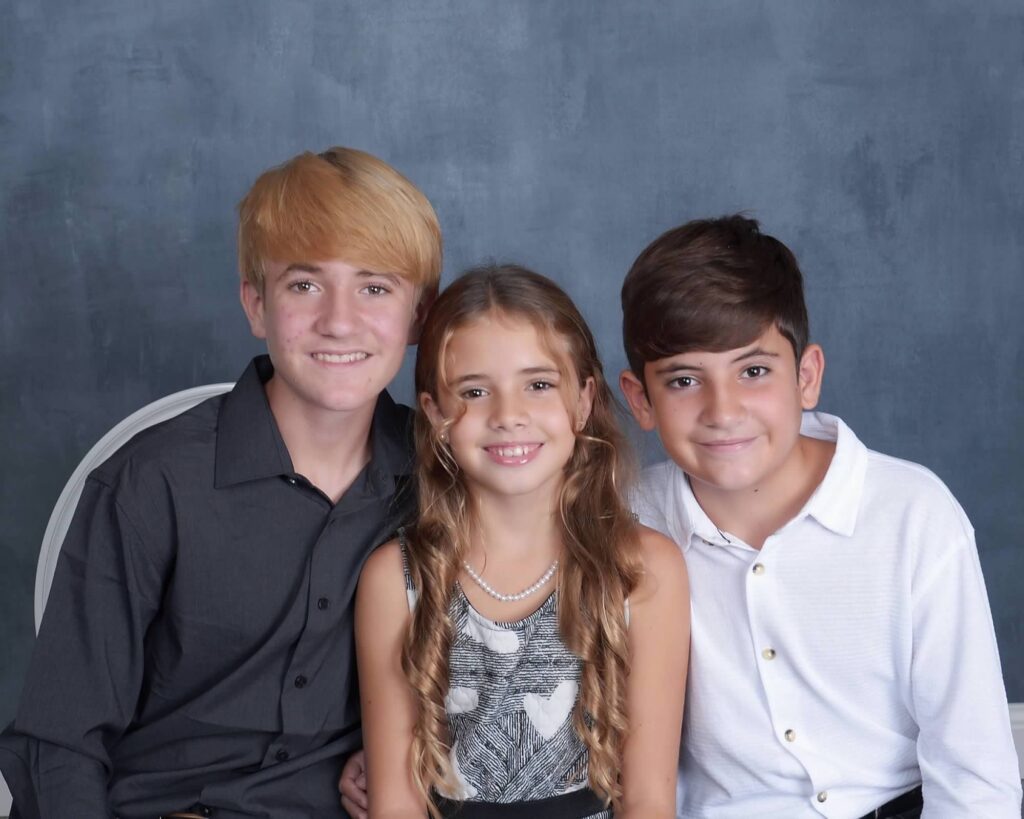
Crescent City is a small community. The city itself is less than three square miles with a population of fewer than 1,700. Ashley said it doesn’t lend itself to home education co-ops and chances for the Jones children to interact with other home-educated students during the day.
“That was the biggest piece that was missing for Joshua, going to school and seeing friends,” Ashley said.
So, when the opportunity was created for Joshua to return to a brick-and-mortar school, even on a limited basis, his parents pursued it. The agriculture class meets during the last period of the day, and Joshua was headed there anyway for sports.
Ashley called it a “great compromise.”
“He's going there to do something that he likes,” she said. “He loves the animals. He loves to learn about them. He’s going there for one of his electives, so that's one less thing that we do at home.
“He's already going to the school at the end of the day anyway, so now he just gets to see his friends and interact with people, and he's in a teacher setting, which I think is a good thing, too. It is hard when it's always mom. So, I think having a teacher also teaches life skills, so I don't think that's a bad thing at all.”
Joshua said he wants to continue with an agriculture class next school year. He would also like to join Future Farmers of America.
“It’s fun,” he said. “I get to go back to the school so I can still hang out with my friends and still get to take a class there.
“I do love learning about animals.”
ST. PETERSBURG, Fla. – Life, it’s often said, is what happens when you’re making other plans.
Tasia Mathis planned on joining the U.S. Navy Reserve. Then her grandmother, with whom Tasia and her younger brother Jeremiah lived with, died suddenly from complications of kidney failure.
“The papers were signed, but I wasn’t able to go through with it,” Tasia said. “I had to make sure he was OK.”
Tasia, 20 at the time, became her brother’s guardian.
While Tracy Crawford’s passing in June 2023 ended Tasia’s goal of joining the Navy, it didn’t end her goal of a bright future for herself and Jeramiah.
For that, she credits Florida's private school scholarships managed by Step Up For Students.
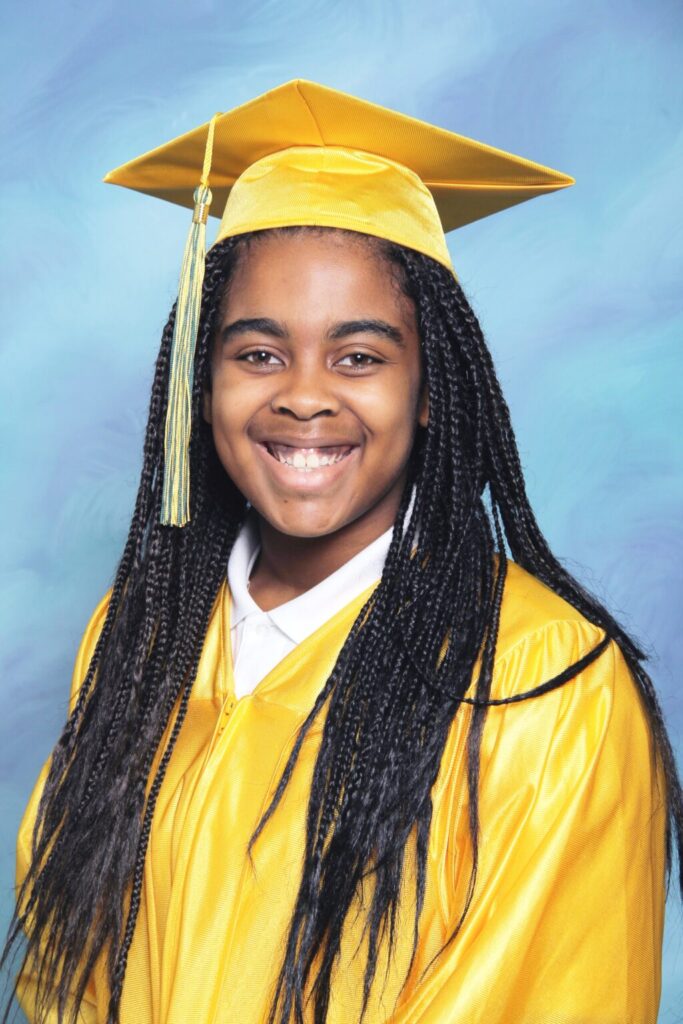
The scholarships enabled Tasia, now 22, and Jeremiah to attend Academy Prep Center of St. Petersburg for middle school and allowed Jeremiah, 15, to continue his private school education at Admiral Farragut Academy in St. Petersburg, where he is a sophomore this year.
“(The scholarship) gave us the opportunity to go to a school that we probably wouldn't be able to go to,” Tasia said. “It gave us the opportunity to expand our knowledge so good things can come into our lives.”
Tasia is studying to become a phlebotomist and works as a teacher at the Academy for Love and Learning in St. Petersburg.
Jeremiah would like to attend the United States Air Force Academy and work in cybersecurity.
The two, who share an apartment in St. Petersburg, have goals and are working toward them with a determination forged by Tracy Crawford, their grandmother, and reinforced by their years at Academy Prep.
“They don’t let you give up,” Tasia said when asked what she liked about attending Academy Prep. “Even if you had issues, they never let you give up.”
Could you blame them if they did?
Tasia was 8 and Jermiah was three weeks old when their mom died. Staci Crawford was only 34 when she suffered a heart attack. That left the children in the care of their grandmother, whose failing health forced Tasia to find work as a counselor at the Police Athletic League when she was 14.
“I had to help out with the bills,” she said. “By the time I was 16, I was cooking, washing everybody's clothes, helping my grandmother out the best I could.”
So, when asked what it’s like to have his sister as his guardian, Jeremiah said, “It’s kind of all I’ve known.”
Tracy wanted Tasia to attend a school that would challenge her academically and offer a safe environment. That’s why she used the private school scholarship to send her to Academy Prep.
At first, Tasia said, it wasn’t a good match. She was not a fan of the school’s long days (7 a.m. to 5 p.m.) or the fact that she had to wear a uniform.
“It took her a while to buy in, and then once she did, she was a high-achiever, and she set the tone for the other kids,” said Lacey Nash Miller, Academy Prep’s executive director of advancement.
For that, Tracy gets a big assist.
“She made sure my grades were straight, my attitude was straight,” Tasia said. “By seventh grade, it all came together.”
For high school, Tasia attended her assigned school because it offered a BETA (Business, Entrepreneurial, Technology Academy) program that interested her.
Jeremiah attended his assigned elementary school, but Tracy wasn’t a fan of his assigned middle school.
“It wasn’t up to her standards,” Tasia said. “She wanted to challenge him.”

So, like his sister, Jeremiah headed crosstown to Academy Prep, where he said he benefited from the school’s academic environment and the self-discipline the teachers try to instill in the students.
Jeremiah said he became more extroverted during his years at Academy Prep.
“I was naturally a quiet person. I didn’t talk much,” he said. “Now, I talk to people. I try to start conversations.”
He also credited his teachers, specifically Zack Brockett, a science teacher, for guiding him toward being a young adult.
“He pushed us to grow up, so that we can go into high school as mature students,” Jeremiah said.
His teachers at Academy Prep describe Jeremiah as a quiet student who completed his assignments on time, helped out around campus, and amazed them with his drawing ability.
“Jeremiah is very self-driven,” Britanny Dillard, Academy Prep’s assistant head of school, said. “He’s one of those people that you kind of underestimate because he's so quiet that you don't even truly realize the talents that he actually has. He’s not the first to raise his hand, but he knows the answer.”
Jeremiah was a member of the school’s track team. He threw the shot put and discus. At graduation, Jeremiah received the Priscilla E. Frederick Foundation, worth $1,500 toward the balance of his freshman year tuition at Admiral Farragut. Frederick is a former Olympic high jumper who competed for Antigua and Barbuda in the 2016 Summer Games. Her foundation awards scholarships and grants to students raised in single-parent households. Jeremiah was the first Academy Prep student to earn that scholarship.
He is a soft-spoken, unassuming young man with a growing vinyl record collection and an interest in graphic novels and comic books. He will participate in track and field this year and will take an aviation class, which he feels will benefit him when he gets to the Air Force Academy.
Jeremiah spends his high school volunteer hours at Academy Prep. He helps grade papers, organize classrooms, and move supplies around campus.
Jeremiah and Tasia are spoken highly of at Academy Prep. Both Dillard and Nash Miller said they were “heartbroken” when they learned of Tracy’s death, and both admitted they were worried for the future of the siblings.
“They only had each other, and I think it speaks highly of Tasia that she was willing to accept that role,” Dillard said.
Said Nash Miller: “The news that her grandmother passed just gutted me. She had all these plans, and she just cancelled them to be her brother’s primary caregiver. What a superhero to put her brother’s needs ahead of her own.”
MIRAMAR, Fla. – Florida’s explosion in à la carte learning has created space for all kinds of new, state-supported educational experiences, including, improbably, a class in building with power tools that’s tucked inside an ashram, a kind of spiritual retreat, with a grove of mango trees and a colony of especially plump iguanas.
The class is run by Builder’s Workshop, an à la carte provider founded by Marvin and Christine Hernandez. The couple retrofitted an old horse stable on the property into a student workshop, humming with saws, drills, and sanders.
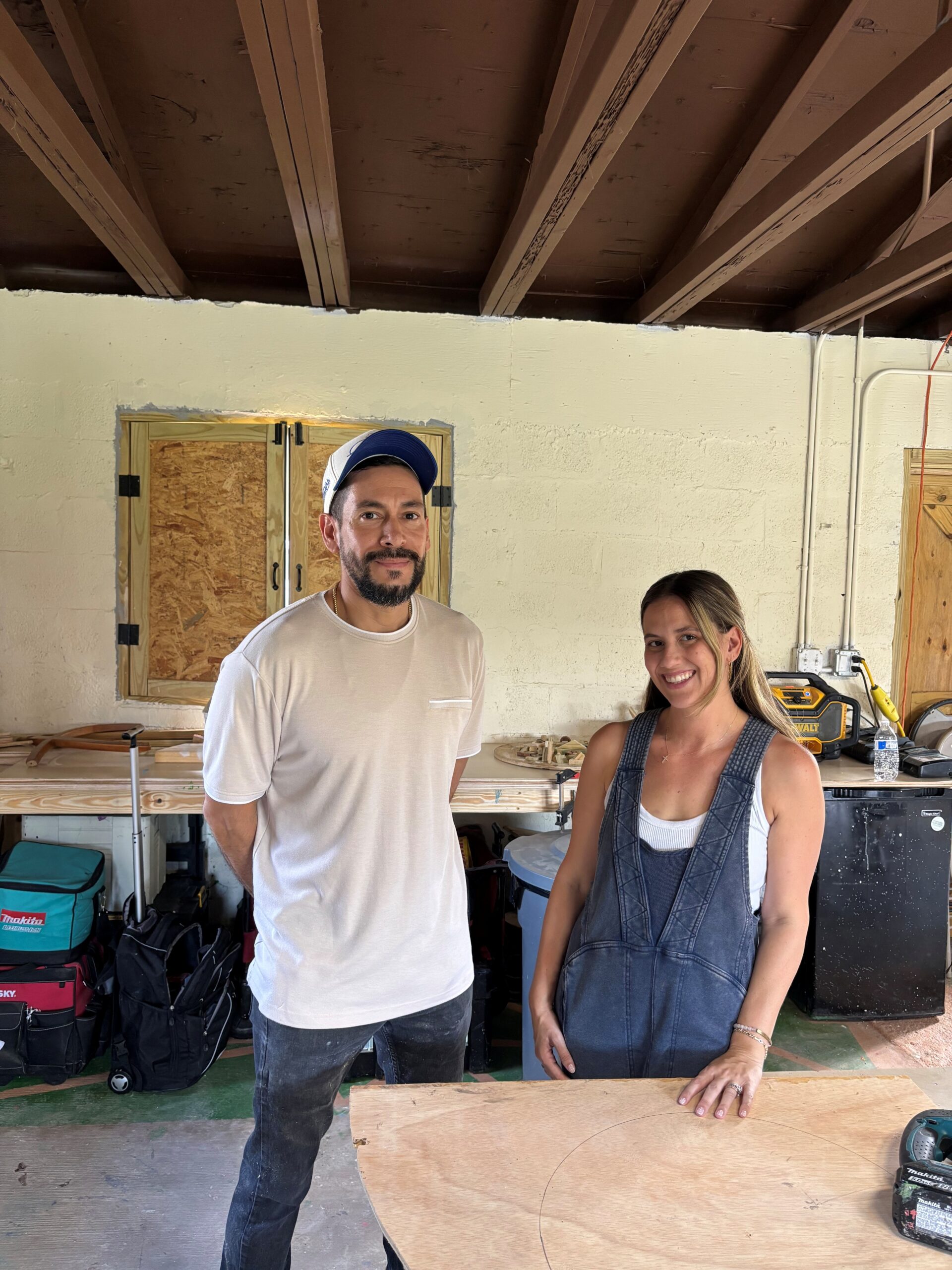
Now, just a few months in, they’re already serving 30 students a week, all in middle and high school. Nearly all of them use education savings accounts (ESAs), the flexible state scholarships that are fueling Florida’s fast-growing universe of à la carte learning.
“They say build it and they will come, and people are coming,” Christine said. “Families are hungry for it.”
The same could be said for à la carte learning in Florida.
Enabled by ESAs, à la carte learning is when families use state support to customize their child’s education completely outside of full-time schools, by picking and choosing from multiple providers. This school year, 140,000 students will do à la carte learning in Florida, up from about 8,000 five years ago, and their families will spend more than $1 billion in ESA funds. As we detail in a new data brief, nothing on this scale is happening anywhere else in America.
As the number of à la carte learners expands, so does the supply of places they can go.
Last year, 4,318 providers received ESA funding in Florida, more than double the year prior. Many of them are tutors and therapists. But a growing number are like Builder’s Workshop, specialized, micro-programs that would have been inconceivable as public education just a few years ago.
Inside Builder’s Workshop, students learn how to operate tools safely and confidently. They build birdhouses, step stools, shoe racks, and in one class I visited, “shields of faith.” Along the way, they pick up habits that rarely come from screens.
“Teaching kids to use tools and build things … builds confidence, responsibility, and real-world skills,” Marvin said. “It teaches them problem-solving, patience, and how to work safely. It also strengthens their math and creativity, gets them off screens, and helps them feel capable of making and fixing things.”
“Plus, from a Christian view,” Marvin continued, “it reflects God’s design for us to create and steward the world around us.”
(Builder’s Workshops offers both secular and Christian classes.)
Some Builder’s Workshop students are members of a Montessori co-op that also uses the property. Some are not. In the rapidly evolving world of à la carte learning, lines blur, and kids, families, and educators cross them freely.

“I just love building stuff,” said student Jasmin Hernandez (no relation to Marvin and Christine), a 16-year-old who wants to be a carpenter. Jasmin spoke briefly between noisy cuts with a band saw.
That DIY attitude is what Builders Workshop wants to cultivate.
“We want them to know they can fix a table if they need to fix a table,” Christine said. But “we also want them to know they can create their own products if they want to.”
Marvin and Christine are fixtures in South Florida’s fine arts scene. Marvin is a longtime artist; Christine has a background in project management. Among other services, their company designs and builds custom display cases, pedestals, and other structures for museums, galleries, and private homes.
So, they know their power tools. They also understand the broader potential.
To date, the expansion of ESAs hasn’t done much to enhance career and technical education. But student interest is growing for those skills and jobs, even as some quarters worry about a lack of qualified teachers. Florida, though, is full of highly trained professionals — builders, craftspeople, men and women skilled in the trades — who could be part of the solution.
Maybe ESAs are the bridge that connects them.
Maybe Builder’s Workshop is a glimpse of what that could look like.
Jasmin’s mom, Michelle Hernandez, said her daughter is already close to graduating because she took so many dual enrollment classes through her prior school. So, Michelle decided to homeschool Jasmin and let her explore more nontraditional classes.
Builder’s Workshop, she said, is “an outlet to be creative but with items that have a purpose. Building things also means not having to wait for others to do it, and she can see her own ideas come to life.”
Jasmin’s 13-year-old brother, Cristian, is also enrolled. Michelle said he looks forward to it because hands-on learning registers more deeply with him. Plus, she said, “He’s a boy. He needs to move.”
Kelly Jacobo said likewise about her son, Malakai, who’s also 13 and taking the class.

Jacobo said her grandfather and great-grandfather were accomplished carpenters, so Builder’s Workshop was perfect. “It kind of runs in the family,” she said. “I’ve been praying for forever that there’d be a woodworking class for kids.”
The backdrop for Builder’s Workshop couldn’t be more colorful. Even though it’s in super urbanized South Florida, it’s hidden down a graded road lined with banana trees. Around the corner is the mango grove, where the iguanas, clearly living their best lives, feast when the fruit is in season.
Alas, this setting is going to fade from the story. The owner recently sold the land, so Marvin and Christine will be looking for new digs soon. They don’t anticipate a problem with demand, however, and the families they serve are devoted.
“We don’t know where or when it will happen,” she said of finding a new place, but “we have an immense amount of faith that more families will join once we open our doors.”

Saltwater Studies in South Florida was founded by education entrepreneur Christa Jewett. It is among the growing number of a la carte providers in Florida made possible by the state's education savings account programs.
Every state’s public education system is a market with supply (i.e., instruction) and demand (i.e., students needing instruction). These markets function as the operating systems for public education. Unfortunately, since the mid-1800s, these markets have been poorly designed and managed. As a result, every state’s public education operating system is deeply flawed.
Just as digital applications fail when their underlying operating systems malfunction, public education programs fail when the market mechanisms beneath them are ineffective. This helps explain why nearly every major reform initiative since "A Nation at Risk" (1983), from site-based decision-making and outcome-based education to teacher empowerment and regulatory accountability, has failed to deliver sustained, systemic improvement.
Public education will not realize sustainable improvement until each state’s public education market becomes more effective and efficient.
Public education’s primary problem is that the supply side of each state’s market is dominated by a government monopoly that also controls most demand side funding. A necessary correction is giving families greater control over a significant portion of the public funds allocated for their student’s education. Thanks to decades of advocacy by the education choice movement, families in 18 states may now use public funds to purchase education services and products from government and nongovernment providers.
But family-controlled funding alone is not enough. Every aspect of the design and management of public education markets must be improved, not just their demand side.
In high-performing markets, supply and demand are in sync; transactions are easy, and transactional costs low; information to guide decision making is transparent and accessible; resource allocation is effective and efficient; risks are managed appropriately, and customer satisfaction is consistently high.
The education choice movement has historically focused on increasing the number of families who control a portion of their students’ education funding while putting less emphasis on ensuring the market’s supply side grows in tandem. This imbalance often causes demand to exceed supply, driving up costs without improving quality and leaving families unable to access the best educational environments for each child. A recent study in Florida found that 41,000 students were awarded education choice scholarships last year but never used them, in part because there was no space in their desired schools.
Policymakers can help by enacting policies that better align supply with demand, ensuring students have access to the options they need.
During the 2025-26 school year, families nationally will spend about $6.75 billion in public funds customizing their children’s education. Emerging Artificial Intelligence tools are already showing promise in streamlining compliance, verifying transactions in real time, and safeguarding public dollars. By adopting these technologies wisely, states can protect taxpayers while reducing bureaucratic burdens on families and providers.
Families shape public education markets through their purchasing decisions. When those decisions are well-informed, they drive higher quality and better prices. Yet in every state, families lack easy access to reliable information about provider performance and pricing. To support better choices, states should create user-friendly tools that provide transparent, trustworthy information. Without this transparency, families are navigating markets in the dark.
Every market decision carries risks and consumes resources. For example, when states implement policies that drive high demand without growing supply, costs rise, and families lose access to the best options for their children. Effective markets require careful regulation and risk management to balance innovation with accountability while ensuring resources are allocated efficiently.
States are responsible for the design, implementation, and ongoing management of public education markets. Their goal should be market optimization, with family satisfaction as the ultimate indicator of success. An optimized market is one where all components function well together, and widespread family satisfaction suggests that children’s needs are consistently being met.
Public education markets are interdependent ecosystems and must be managed as such. When states align supply and demand, reduce friction, expand transparency, and manage risk wisely, they create conditions where every family can access instruction tailored to their child’s needs.
Lasting improvement will not come from the next reform fad. It will come from building healthy markets that empower families and unlock the full potential of every student.
Choice opponents have been known to throw contradictory arguments out against private choice programs. One moment they will claim that the majority of kids using universal choice programs were already going to private schools. A few moments later they will claim such programs are draining district schools of students and money. The irony of these mutually exclusive claims will often escape the person making them, and you can see hints of both in this New York Times podcast titled Why So Many Parents are Opting Out of Public Schools.
Sigh
Choice opponents make all kinds of claims, but not many can withstand even a modicum of scrutiny. Let’s take for instance a widely repeated fable- that Arizona’s universal ESA program has “busted” the state budget.
If you actually examine state reports like this one for district and charter funding and also this one for ESA funding, you wind up with:
Arizona districts have exclusive access to local funding among other things and are by far the most generously funded K-12 system in the state. Districts, charters and ESAs all use the state’s weighted student funding formula, and ESAs get the lowest average funding despite having a higher percentage of students with disabilities participating than either the district or charter sector.
If you track the percentage of students served by the district, charter and ESA sectors respectively, and the funding used by each as a percentage of the total, you get:
So, there you have it; supposedly the sector educating 6% of Arizona students for 4% of the total K-12 funding is “bankrupting” the state of Arizona. Meanwhile the system, which generated an average of $321,700 for a classroom of 20 ($16,085*20), is “underfunded.”
A group of 20 ESA students receiving the average scholarship amount receive $123,780 less funding, but they are (somehow) “busting the budget.” The fact that a growing number of Arizona students opt for a below $10k ESA rather than an above $16k district education tells us something about how poorly districts utilize their resources. So does the NAEP.
There is a school sector weighing heavily upon Arizona taxpayers, but it is not the ESA program.

Berkeley law professors Jack Coons (left) and Stephen Sugarman described what we now call education savings accounts - and a system of à la carte learning - in their 1978 book, “Education by Choice.”
John E. Coons was ahead of his time.
Decades before the term “education savings account” became an integral part of the education choice movement, the law professor at the
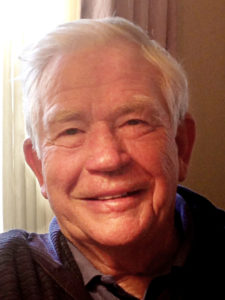
Jack Coons, pictured here, co-authored "Education by Choice" in 1978 with fellow Berkeley law professor Stephen Sugarman.
University of California, Berkeley, and his former student, Stephen Sugarman, were talking about the concept. In their 1978 book, “Education by Choice: The Case for Family Control,” the two civil rights icons envisioned a model drastically different from the traditional one-size-fits-all, ZIP code-based school system inspired by the industrial revolution:
“To us, a more attractive idea is matching up a child and a series of individual instructors who operate independently from one another. Studying reading in the morning at Ms. Kay’s house, spending two afternoons a week learning a foreign language in Mr. Buxbaum’s electronic laboratory, and going on nature walks and playing tennis the other afternoons under the direction of Mr. Phillips could be a rich package for a ten-year-old. Aside from the educational broker or clearing house which, for a small fee (payable out of the grant to the family), would link these teachers and children, Kay, Buxbaum, and Phillips need have no organizational ties with one another. Nor would all children studying with Kay need to spend time with Buxbaum and Phillips; instead, some would do math with Mr. Feller or animal care with Mr. Vetter.”
Coons and Sugarman also predicted charter schools, microschools, learning pods and education navigators, although they called them by different names.
Fast forward to Florida today, where the Personalized Education Program, or PEP, allows parents to direct education savings accounts of about $8,000 per student to customize their children’s learning. Parents can use the funds for part-time public or private school tuition, curriculum, a la carte providers, and other approved educational expenses. PEP, which the legislature passed in 2023 as part of House Bill 1, is the state’s second education savings account program; the first was the Gardiner Scholarship, now called the Florida Family Empowerment Scholarship for students with Unique Abilities, which was passed in 2014.
Coons, who turned 96 on Aug. 23, has been a regular contributor to Step Up For Students' policy blogs over the years. Shortly after the release of his 2021 book, “School Choice and Human Good,” he was featured in a podcastED interview hosted by Doug Tuthill, chief vision officer and past president of Step Up For Students.
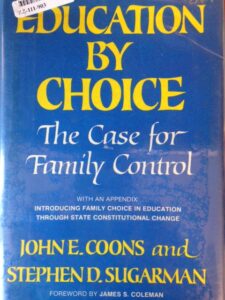 “It is wrong to fight against (choice) on the grounds that it is a right-wing conspiracy,” said Coons, a lifelong Catholic whom some education observers describe as “voucher left.” “It’s a conspiracy to help ordinary poor people to live their lives with respect.”
“It is wrong to fight against (choice) on the grounds that it is a right-wing conspiracy,” said Coons, a lifelong Catholic whom some education observers describe as “voucher left.” “It’s a conspiracy to help ordinary poor people to live their lives with respect.”
In 2018, Coons marked the 40th anniversary of “Education by Choice” by reflecting on it and his other writings for NextSteps blog.
He said he hopes his work will “broaden the conversation” about the nature and meaning of the authority of all parents to direct their children’s education, regardless of income.
“Steve (Sugarman) and I recognized all parents – not just the rich – as manifestly the most humane and efficient locus of power,” he wrote. “The state has long chosen to respect that reality for those who can afford to choose for their child. ‘Education by Choice’ provided practical models for recognizing that hallowed principle in practice for the education of all children. It has, I think, been a useful instrument for widening and informing the audience and the gladiators in the coming seasons of political combat.”

Denise Lever with her students at Baker Creek Academy, a tutoring center in Eagar, Arizona. Photo provided by Denise Lever
Nothing can stop Denise Lever. Not a raging wildfire and certainly not a state fire marshal’s effort to shut down her tutoring center by trying to impose regulations that could have forced her to spend $70,000 on building upgrades.
As one of the nation’s few female wildland firefighters in the late 1980s, Lever survived the hazing that came with being a woman in a male-dominated profession by proving herself and never backing down.
For example, take this story: Lever’s team had been dispatched to a California fire. Roads were closed, and the crew had to climb up a cliff to get into position. Loaded down with their gear, they pulled together and worked through the night.
“It was absolutely brutal,” Lever recalled. “It was hot. It was windy. Our hands were cut up from moving brush, and we lost gloves in the middle of the night, and we couldn’t find them on the fire line because of the debris.
As morning broke and a cold Pacific Ocean breeze stung their faces, the team huddled together in space blankets and reflected on their victory.
“The camaraderie and the sense of accomplishment, they’re irreplaceable,” Lever said.
Lever’s days of battling blazes ended when she got married and became a homeschool mom to three kids, but her trailblazing spirit stayed with her when she became an education entrepreneur.
In 2020, she opened Baker Creek Academy, a tutoring center/microschool to support homeschool families in Eagar, Arizona, just west of the New Mexico state line. The center operates four days a week for five hours per day and serves about 50 students, who attend on different days at various times. Baker Creek provides a host of supplemental services, primarily to homeschooled students, from one-on-one tutoring to limited classroom instruction and group projects to field trips. Students and parents can customize the services that best fit their needs. Baker Creek doesn’t keep attendance records because, Lever said, parents are the ones in charge.
After completing her city’s approval process, Baker Creek began operating in a historic commercial building once occupied by a church, shared with three other independent microschools.
One day, out of the blue, an official at the Arizona Office of the State Fire Marshal left Lever a voice mail message. He wanted to inspect her “school.”
“And I said, ‘No, not really, because we're not a school,’” she said.
As an experienced firefighter, Lever recognized a school designation for what it was: the potential kiss of death for her tutoring center.
Being labeled a school triggers a list of code restrictions intended for campuses that serve hundreds or sometimes thousands of students and often include sports fields, playgrounds, auditoriums, cafeterias, gymnasiums, classrooms, and offices.
On the line are often tens of thousands of dollars in mandated building changes, which are not required for other commercial buildings, such as dance studios and karate dojos.
Levers wasted no time. She contacted the Stand Together Edupreneur Resource Center, which offers guidance, but not legal advice, about regulatory issues. The representative encouraged Lever to contact the Institute for Justice, a national public interest law firm that specializes in education choice litigation and zoning issues.
IJ Senior Attorney Erica Smith Ewing sent a letter to the state’s fire inspector questioning the basis for the inspection.
“Ms. Lever successfully completed a local fire safety inspection in 2023 and has been operating successfully with no problems,” the letter said. “Your request to inspect her property was unexpected. Could you please explain why you wish to inspect her property? We do not currently represent Ms. Lever, and we hope that formal representation will be unnecessary.”
Lever said she faced the possibility of having to spend tens of thousands of dollars upgrading doors and electrical systems. Because the building was smaller than 10,000 square feet, she avoided the order to install a sprinkler system, which can cost $100,000.
However, the timing couldn’t have been worse.
“If the state was going to require some of these upgrades, that was just not going to be possible for (our landlord) to renew our lease,” she said, adding that she used the building to host summer programs and annual meetings for other microschool leaders who use her consulting services.
Lever also wondered why similar businesses weren’t targeted -- for example, a dance studio across the street that taught school-age students and operated similar hours to Baker Creek.
“Because she offered dance instead of math tutoring, her program was considered a trade, and our program was going to be shut down and treated like an education facility simply because we offered more of an academic program,” Lever said.
State officials performed the inspection, but finally backed down, offering only that the situation was a result of “confusion” and the Lever’s business wasn’t under their jurisdiction.
“Forcing Denise to follow regulations designed for sprawling, traditional schools would be both arbitrary and unconstitutional,” Ewing said. “More and more, we are seeing state and local governments hampering small, innovative microschools by forcing them into fire, zoning, and building regulations that never anticipated microschools and that make no sense being applied to what microschools do.”
In Georgia, local officials tried to force a microschool to comply with unnecessary inspections and building upgrades, in violation of state law protecting microschools. They backed down after a letter from IJ. And in Sarasota, Florida, Alison Rini, founder of Star Lab, nearly closed her doors this spring when the city interpreted the fire code to require she install a $100,000 fire sprinkler system, despite operating from a one-room building with multiple exits. Only after a donor provided a generous gift was she able to stay open.
“Teachers shouldn’t need lawyers to teach,” said IJ Attorney Mike Greenberg. “Bureaucrats shouldn’t use outdated and ill-fitting regulations to stifle parents and students from choosing the innovative education options that best suit their needs.”
Lever said the state’s decision to back off sets a precedent that will help other microschools across Arizona.
“I was definitely willing to go forth with the lawsuit,” she said. “At this point, though, we’re going to take our win. We’re going to publicize it so the other microschools will know what their options are.”

Travis and Nikki Leck are seeking to defend and protect the Wyoming Steamboat Legacy Scholarship program from a lawsuit filed by the state teachers union. Their sons, Tanner, left, Carter, center, and Mason, right, attend a private classical school. Photo courtesy of the Leck family
Editor's note: This story has been updated to reflect the latest court ruling granting an injunction to block the release of funds to families while the lawsuit is pending.
Travis and Nikki Leck were thrilled to find a private school that challenged their sons academically and were looking forward to using a newly expanded Wyoming education choice scholarship to help pay for it. Now, a judge's ruling has left them and thousands of other families in limbo as the new school year approaches.
 “We would have never considered a private school. It just isn't something most people in this part of the world do,” said Travis, a petroleum engineer who grew up in Montana.
When the time came, the two public school graduates looked for a public school best suited to the needs of their oldest sons, Mason and Tanner. They found a gem: Fort Caspar Academy, a classical public school focused on high academic standards, high time on task, high expectations for behavior, strong parental involvement, logical thinking, and character development.
The school offered evidence-based reading instruction that included phonics, and math instruction grounded in a solid foundation of math facts, everything the Lecks expected.
Then came third grade. The family had the opportunity to move back to Cody, where they had lived off and on over the years. It's the gateway to Yellowstone National Park. Named after its founder, William F. “Buffalo Bill” Cody, it boasts a population of 10,305. The 2025 graduating class at Cody High School totaled 145.
Cody has one McDonald’s, one grocery store, and a Walmart. Elementary school options were about as limited as the retail offerings. Cody had five public elementary school options, two more than 20 miles out of town, compared with Casper’s 20. The Lecks tried the Cody public school for the twins and their youngest son, Carter, who had started kindergarten.
After a year and 11 days into the next school year, the Lecks realized that they preferred the classical approach to teaching and learning.
 “I never thought we would be at a private school, especially in Wyoming. However, being pro-classical education, especially in Cody, definitely makes me pro-school choice. We have exactly one chance to get our kids’ educational foundation right, and it matters.”
“I never thought we would be at a private school, especially in Wyoming. However, being pro-classical education, especially in Cody, definitely makes me pro-school choice. We have exactly one chance to get our kids’ educational foundation right, and it matters.”
The Lecks decided to look elsewhere for the rigor they wanted for their kids, advanced math learners who are now 12 and 9. They found it at Veritas Academy, a private classical school that used the same standards, curricula, and methods as Fort Caspar Academy. Tuition for the upcoming year will be $8,000 per student.
So, they pulled back on discretionary spending to make Veritas Academy possible. Nikki also returned to her job in marketing full time.
In March, the family got hope for financial relief when the Wyoming Legislature passed the Wyoming Steamboat Legacy Scholarship Act. The education savings account program offers families $7,000 annually for income-eligible students in pre-kindergarten, with universal eligibility for students in K-12. Parents can direct the funds for tuition, tutoring, and other approved educational expenses.
The Lecks were among more than 4,000 families approved for scholarships.
Two weeks before the state was set to begin distributing funds, the Wyoming Education Association and nine parents sued the state to halt the program, arguing that it is precluded by the state’s constitutional commitment to district schools and that it violates a constitutional ban on appropriations to private entities, even though money is appropriated only to the state Department of Education and administered by the state superintendent of public instruction, according to the legislation. The state’s attorney, Mackenzie Williams of the Wyoming Attorney General’s Office, said during a recent court hearing that school funds are not used to finance the ESA program.
Travis and Nikki, who have advocated for parent-directed education in emails to lawmakers, joined forces with EdChoice Legal Advocates and the Institute for Justice as one of two families intervening to defend and protect the program.
On June 27, a district judge granted what he called a “narrowly tailored” injunction that barred any money from going to families while he decided whether to pause the program until the lawsuit was decided. On Tuesday, he issued a written order granting the plaintiffs' request for a preliminary injunction blocking the release of any funds to families until he rules on the case. However, he allowed other operations to continue until he decides whether to issue a preliminary injunction that would pause the whole program while the lawsuit is resolved. Wyoming State Superintendent of Public Instruction Megan Degenfelder said her office is working with the state attorney general to look for options to challenge the injunction. Attorneys for the intervening families said Wednesday they plan to do the same.
"The court's decision to limit educational opportunity for Wyoming families is contrary to the Wyoming Constitution," said Thomas M. Fisher, executive vice president and director of litigation for EdChoice Legal Advocates. "We will seek to stay the injunction and appeal it as soon as possible."
The Lecks say they will find a way despite the latest ruling to keep their kids at Veritas Academy, though it won’t be easy.
However, they worry about those who aren’t as fortunate.
“I know there are a lot of other families that would like to go to Veritas this fall that it will probably hurt if funding is blocked,” Nikki said.
The Lecks said they do not oppose public schools. They graduated from their local public high schools and believe they received a good education. They never gave private school much thought until it became clear their kids needed something different from what that particular public school district offered.
They just think all families should have the right to choose what’s best for their children, whether that looks like a public school, private school, homeschool, or a combination of many options. Larger Wyoming communities like Casper, Cheyenne, and Laramie have publicly funded public and charter school classical school options that aren’t available in smaller communities.
Nikki hopes that the Steamboat Legacy Scholarship program, if it survives the legal challenge, will create an environment for entrepreneurs to provide more types of education. More is particularly important in rural areas like Cody, where choices are scarce and where families have little recourse if existing options are not the best fit.
“Really, a person’s only option if you don’t like what the public school is doing is to take them out and put them somewhere else,” Nikki said. “Wyoming’s scholarship program,” she said, “is one option to make that less financially challenging for anyone, regardless of location or income.”
ORLANDO, Fla. — The whiplash of uncertainty has buffeted the nation’s charter school movement during the past five years. First, COVID-19 disrupted learning for millions of students . That was, followed by restrictions on federal grant money. Then came a lawsuit challenging the public status of charter schools.
The leader of the National Alliance of Public Charter Schools empathized as the movement’s annual conference kicked off on Monday.
“Starting, running and teaching at a charter school has never been easy,” the alliance’s CEO Starlee Coleman said during her keynote speech to more than 4,000 charter school representatives. She said plenty of changes lie ahead.
“Some of the changes you’re going to like, and some will be hard.”
But charter school supporters also had plenty to celebrate, including the sector’s growth alongside private school choice, students who outperformed district peers on national tests, and state laws that require charters to receive a share of capital funding. The U.S. Department of Education also infused an additional $60 million into the fund for charter schools, bringing the total to $500 million to support charter school expansion.
Leaders also hailed the opportunities created by the rise of private school education savings accounts, or ESAs, which have skyrocketed in popularity in states that have passed them.
“Choice is working. Choice is here to stay,” said Hanna Skandera, CEO of the Daniels Fund and a former secretary of education in New Mexico. Skandera was one of a four-member panel that discussed the future of charter schools.
Leaders in Texas and Florida discussed how to seize those opportunities by offering a la carte courses to students with ESAs. Florida, where in 2023 lawmakers made all K-12 scholarship programs into ESAs that are universally available and created the Personal Education Program for students not enrolled full-time in a public or private school, has already recruited school districts and charter schools to provide access to part-time classes. The latest to sign on is Charter Schools USA, which announced a collaboration with Step Up For Students earlier this week to expand options for students.
"This is the future, and it's great to see,” said Derrell Bradford, president of 50CAN and who serves on several charter school boards. “These sorts of collaborations are what happen when families are in the driver's seat, and they have real resources to direct the education of their children. I hope more states and providers follow them on the path to educational pluralism."
Texas won’t start offering its ESA program until 2026, but in preparation a coalition of charter school leaders has already started a pilot program for private-pay students at four schools. They offer a la carte classes online and in person, including some after school.
“We think this is an opportunity, not as a threat,” said Raphael Gang, K-12 education director at Stand Together Trust.
The panel advised those considering offering part-time services to capitalize on their strengths when deciding what to offer, start small and educate parents on how to access the programs.
In Florida, where education choice scholarship programs have been in place since 1999, representatives shared the history leading up to the state’s 2023 passage of House Bill 1, which converted all choice scholarships into ESAs and made them available to all K-12 students. That law also established a new ESA, the Personalized Education Program, for students who are not enrolled full-time in a public or private school. PEP allows parents to use $8,000 per student to create a customized education for their children.
“It has been a game-changer,” said Keith Jacobs, assistant director of provider development at Step Up For Students. Jacobs, a former charter school leader, works to recruit and onboard charter schools and school districts as providers of part-time services for ESA students.
Jacobs said school choice used to exist only for families who could afford private school tuition or buy a home in a certain ZIP code, but ESAs have taken choice to a new level.
“We have placed the funds in the hands of the parents,” he said.
What does that look like?
It might be a virtual class in the morning, band at a public school in the afternoon, and a session with a private tutor.
“Or it might be ‘My child needs an AP bio class and the charter school down the street has a good bio teacher,’” he said.
Charter Schools USA Florida Superintendent Dr. Eddie Ruiz said the decision to offer courses to part-time students was easy given the demand for flexibility.
“Charter Schools USA believes in innovation,” Ruiz said. “It’s given parents the flexibility to really design their student’s education.”
He said when he approached his principals about the idea, they wondered how it could be done. Ruiz compared it to Amazon.
“Parents can just pick and choose,” he said. “Whatever it may be, they design their educational experience.”
The implementation will look different for each state based on the laws, but in Florida, approved providers can list their offerings and prices on an online platform, where parents can purchase the services with their ESA funds.
Charter schools set their prices based on local costs, said Adam Emerson, executive director of the Office of School Choice for the Florida Department of Education. In calculating those, leaders should not overlook operational costs, such as putting the students in the school information system.
Emerson said serving ESA families is a financial win for charters, but also the chance to make a positive difference for students in their communities.
“Yes, it’s a revenue stream, but it’s also a calling,” he said.